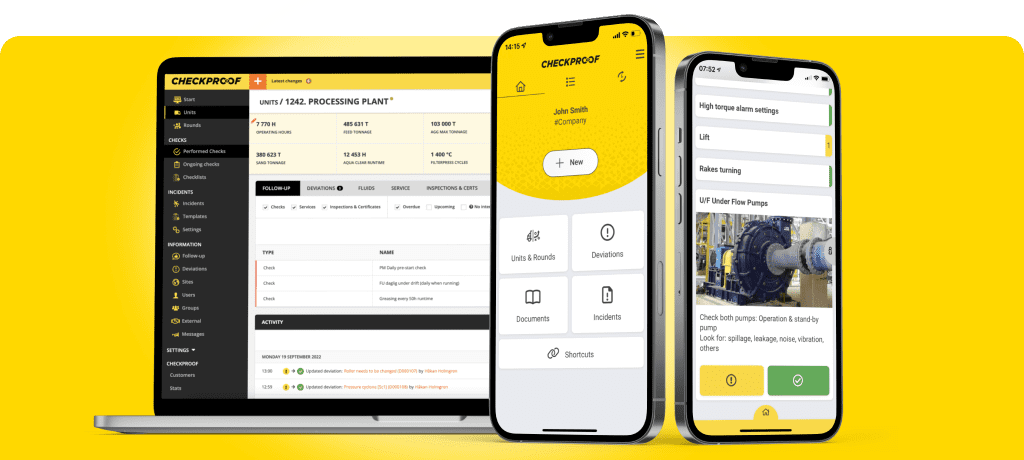Visit us at NRMCA’s ConcreteWorks 2024, Colorado, US: 12th - 13th Oct
A guide on managing staff schedules and the absence of key staff within construction materials and heavy industry during the holidays.
Understanding the Impact of Holiday Absences on Your Operations
Do the long summers and the prospect of key staff on holiday during vacation periods keep you up at night? The holiday season brings its own set of unique challenges for the construction materials and heavy industries. Field staff possess fine skills that require training and experience to ensure safe operations. Therefore, if you don’t plan carefully, the absence of key staff can disrupt workflows, compromise on-site safety, delay assignments, and impact overall productivity. Appreciating the potential impact absences can have is important and addressing them in advance is a smart strategy to maintain operational efficiency.
In this article we’ll cover:
Planning: Strategies for Managing Staff Absences
A good plan is a good friend when organizing staff holidays, yet your best plan is a proactive work culture already embedded into everyday workflows. We walk you through some popular strategies that should be part of workers’ weekly schedules, regardless of holidays (but will serve you especially well during them!).
- Cross-training: Let staff work in pairs to encourage skill-sharing and training each other to develop a multi-skilled team.
- Job Rotation: It can be tempting to let certain staff operate machines they are more skilled at. However, it does little for staff morale, or future-proofing your business. Companies are well served by rotating workers according to two-week shifts, so every two weeks workers get a variety while routines and operating skills become ingrained. Win-win!
- Scheduling: Encourage early holiday requests so you can plan with ease. This lets you adjust shifts and schedules accordingly so that key staff with similar job functions don’t overlap.
- Contractors: Develop long-term relationships with contractors and temp agencies who can quickly fill in for absent employees. This will maintain productivity levels and reduce the burden on remaining team members.
The lack of skilled workers affects workplace productivity and safety, but the above strategies will help minimize disruptions and secure operational continuity during the holidays.
Leveraging Technology to Maintain Productivity
Technology is a powerful ally in managing staff absences and maintaining productivity. Below are some practical examples of integrating technology into daily workflows to allow for a foolproof transfer of knowledge and reduce the chance of key information falling through the cracks.
Automated Processes: Automate routines and processes with multiple access to everyone. Ensure critical processes are accompanied by clear step-by-step guides, thus reducing dependency on key staff.
Digital Checklists: Implement digital checklists for tasks and inspections. This allows any available team member to complete tasks accurately and efficiently, regardless of their usual role.
Real-Time Reporting: Use real-time reporting features and systems to monitor progress and identify potential bottlenecks. This helps in reallocating resources and addressing issues promptly.
Inventory Management: Don’t run out of parts because key staff are away. Systems that track stocks in real-time will contribute to overall visibility across sites and ensure you don’t drop below a certain level.
Remote Access: Enable remote access to essential systems and data. This allows managers and supervisors to oversee operations and provide support even if they are not physically present.
By leveraging technology, you can maintain productivity and ensure that your operations run smoothly despite the holidays. For further guidance, check out our guide on the 9 keys to maximizing availability through frontline digitization.
Communication: Keep everyone in the loop
Daily pre-start meetings, weekly health & safety check-ins, and systems that enable smooth communication between team members are all key to keeping operations running efficiently during the holidays. Keep the following communication checklist near during the holidays!
- Communication channels: Establish clear communication channels for both on-site and remote staff. Learn how CheckProof can help bridge the communication gap between frontline workers and the office.
- Regular updates: Although regular updates should be part of the communication DNA at plants and sites, they become even more pertinent during the holidays. Provide regular updates during team updates on staffing levels, workload distribution, project progress, and reassigned tasks. This keeps everyone informed and fosters collaboration and teamwork.
- Documentation: Ensure all Standard Operating Procedures (SOPS) are well-documented. You can download manuals and SOPs onto CheckProof’s platform so staff can refer to guidelines and complete tasks with ease – even if they fall outside the remit of their usual tasks.
- Daily pre-start meetings – this is a great way to keep staff up to date during the holidays. It signals engagement and contributes to transparency around tasks as well as promotes accountability.
Maintaining open lines of communication helps in effectively managing staff absences and ensures that your team remains aligned and productive.
How CheckProof’s platform can help address staff absences
During holidays, tasks constantly need to be reassigned, rescheduled, and reprioritized. Leaning into CheckProof’s platform can help solve this headache. Here’s a handful of features that will make life easier for your team on site.
- Notifications & Mentions: Get instant notifications on your dashboard or app so you can be notified of urgent tasks. Use mentions to tag team-members for immediate communication.
- Assignments: Easily assign checks and tasks to individuals or groups of people directly from the app or dashboard.
- Select smart IoT devices: For a connected plant, devices such as Pigeon which was developed by CheckProof, enable the transfer of operating data directly from the process units to the CheckProof platform. You can then select up to eight measurable factors, such as operating hours or produced quantity – and use them as triggers for maintenance routines. Allocate the maintenance task to the temporary staff on hand.
- Customizable Checklists: Create and customize checklists to suit your needs. This ensures that tasks are completed consistently, regardless of who is available.
- Planning tool: This feature allows for optimal resource allocation and optimization. Any updates or notes you make to a task in the planning tool on your desktop will appear in real-time on the assigned employee’s personal to-do list in their mobile app. As a result, everyone is kept up to date with tasks that are relevant to them. And since everything is logged automatically, you can always go back to see what has (and hasn’t) been done in the past.
Managing staff absences during the holidays can be daunting for managers and team leaders. However, with careful planning and leveraging technology, you can reduce the dependency on specific individuals and rest assured that your operations stay efficient and productive.
Holidays should not instill panic in teams, but instead should be recognized as a welcome rest that all of us need and rely on to continue staying productive. This is perhaps truer for workers operating in heavy industries.
So, apply the tips above, lean into the holidays, and enjoy the welcome break.
Want to know what CheckProof can do for you?
CheckProof's easy-to-use app makes it easier to do the right thing at the right time. Discover how you can run world-class maintenance that is both cost-effective and sustainable.

SBMI’s Climate Roadmap for a Fossil-Free Aggregate Industry by 2045

HSEQ trends in the Construction Materials and Heavy Industry

10 Tips to Reduce On-Site Costs in the Construction Materials & Heavy Industry

Inventory Management Systems for the Aggregates Industry

Managing Key Staff Absences During the Holidays

The Hillhead Report

Predictive maintenance using IoT

How your workplace health and safety policies can improve your sustainability work

Heavy Equipment Maintenance






